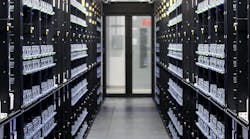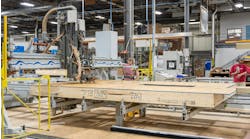These days you an’t travel far on State Highway 28 in northern Virginia without seeing a directional boring machine off the side of the road. Like lumbering, mechanized anteaters, they pierce the earth with their metal snouts from Ashburn to Manassas, guided by crews that work seemingly around the clock. Rather than pulling a prize from the ground, though, those beasts are making a deposit — a fiber-optic investment in the future of business in the commonwealth. And they can’t do it fast enough.
If there is a center of the digital universe, it’s Loudoun County, Va. Just northwest of Washington, D.C., this 500-square-mile parcel of land is home to just 375,000 people but nearly 15 million square feet of data center space. By the end of 2017, data centers in the area accounted for 115MW of power usage; the next closest data center market in the United States — Chicago — accounts for just 44MW.
The locus of all that activity in northern Virginia is in the city of Ashburn, through which a staggering 70% of the world’s Internet traffic flows. Yes, you read that correctly: Nearly three-quarters of all Google searches, social media posts, emails, and cat videos pass through servers in this modest county outside of the nation’s capital. And those who watch the data center market closely see no reason why that will change any time soon.
“It’s been quite the crazy market,” says Bo Bond, a managing director and co-lead of the data center practice at JLL, a real estate investment management firm. “Right now, the big story is that supply is trying to catch up with demand.”
While northern Virginia is certainly the largest — and hottest — market for data center construction in the United States, there are plenty of opportunities for enterprising electrical contractors in other cities (see The Next Ashburns below). But the story of its transformation into the hub for this kind of work is not only a fascinating examination of what capitalizing on good luck can do for a local economy, but it also offers useful insight into what it takes to compete in the industry.
Sweet home Virginia
Loudoun County’s ascension to the top of the data center world began, of all places, underground. In the early 1990s, the Internet may not have been top-of-mind for the average American, but the telecom world had been busy for decades building out the infrastructure that would lead to its ubiquity.
“You just had a rich electrical and telecom infrastructure that was there that has made growing in that market easier than in other places,” says David Liggitt, the president of datacenterHawk, an industry analysis firm.
So it was in 1992 that several providers in the area decided to join forces and combine their networks. From that came MAE-East, an early Internet exchange point, through which online traffic traveled. Andrew Blum wrote about the nondescript location, which was located in a parking garage, in his 2012 book: Tubes: A Journey to the Center of the Internet.
“Air conditioning units surrounded the bare white walls, hard up against the underground parking spots. A generic hardware store ACCESS RESTRICTED sign marked the door. The undisputed capital of the Internet was decidedly humble, the kind of space where you’d expect to find floor-polishing machines and toilet paper stocks, not the spinal cord of a global information network.”
That initial investment in northern Virginia set the stage for explosive growth not just locally but up and down the East Coast: MAE-East would eventually expand to include hubs in New York and Miami, among other cities near D.C. The biggest leap forward, however, would have to wait nearly 15 years.
You’ve got work
Data center customers break down into two categories: enterprise users and the developers who build, manage, and lease facilities. Although a handful of big enterprise players have built out their own massive data centers in the area, it was the latter category that may have made the biggest impact on the market in northern Virginia.
The developers — chief among them DuPont Fabros, Equinix, and Digital Realty — have had a presence in northern Virginia since the beginning of the 21st century. But it wasn’t until the middle of the first decade, after the dot-com bubble burst and the Internet economy began to recover, that construction began in earnest. (Legislation that exempted qualifying projects from sales taxes, passed in 2009, certainly helped.)
Power Solutions was one of the electrical contractors well-positioned to capture some of that early work, and it wasn’t long before it established itself as a premier player in the marketplace. Kenny Johnson, senior vice president of the firm’s technology group, says Power Solutions has built 5 million square feet of data center space in Loudoun County and neighboring Prince William County just since 2013.
Power Solutions is based just east of D.C., in Bowie, Md., so it had deep roots in the area prior to the data center market’s massive growth after the turn of the century. (Its Ashburn, Va., office opened just last year.) In fact, it knew the telecom industry well, thanks to existing relationships with AT&T and Bell Atlantic-Verizon that stretched back to the 1990s.
While geography was one of the deciding factors in Power Solutions’ rise to data center dominance in northern Virginia, Rosendin Electric had to rely on something else entirely. Based in San Jose, Calif. — the heart of Silicon Valley — it followed one of its well-known social media customers to the Mid-Atlantic in 2011. That first data center job was in North Carolina, but it wasn’t long before that same customer expanded its East Coast portfolio north to Ashburn. (You can probably guess who that customer might be, but don’t bother asking. The data center world is a notoriously secretive one. As one person familiar with the customers’ frequent demands for non-disclosure agreements says, “It’s like Fight Club. You just don’t talk about it.”)
While Johnson estimates that 60% of Power Solutions’ data center work has been for enterprise clients, Rosendin’s projects skew heavily the other direction. Brobst says more than three-quarters of the firm’s data center work in northern Virginia is for developers.
That split is reflective of an industry-wide shift that began to occur five or six years ago, when one Internet company after another began to abandon its own facilities in favor of collocated spaces owned and operated by companies like Equinix and Digital Realty.
“If you can lease a data center space, as opposed to laying $150 million out to build one, and you don’t have to maintain it, the business case works a little better,” Brobst says. “Even some of the enterprise users that have existing data center spaces are capitalizing on those assets right now by selling them to third parties and then turning around and leasing space in them.”
High-speed work
Regardless of who’s paying for the work, the trends dominating the industry now — whether in northern Virginia or elsewhere — are tight supply and severely compressed construction schedules.
What makes this specific supply-demand equation particularly unique is the way these buildings are built. Imagine Data Center Developer X announces it has bought several acres of land in Loudoun County to build a 500,000-square-foot facility. When construction begins, that developer may or may not have already leased part of the building to a tenant. So rather than complete the entire structure, it will construct the shell and then build out portions within that building, known as “halls,” in stages. This does two things: It allows the developers to minimize the risk of not being able to lease a fully functional facility, and it means the contractors building out those halls will end up doing the work in stages. But with demand as intense as it has been in the last five years, developers are rarely sitting on unused space.
“The good thing about the industry is that it costs a lot of money to build a data center, which keeps developers out of the market who don’t understand it,” says Liggitt, of datacenterHawk. “The bad thing is that with fewer developers in the market, that can wreak havoc on supply.”
That said, there are still the occasional data centers built on spec.
“The average enterprise user that takes 500kW up to 5MW, they want to come in, see it, touch it, smell it, and make sure it’s been Level 5 commissioned and understand the electrical and mechanical behind it,” says Bond, of JLL. “That’s when they’ll say, ‘Yeah, build me a cage on that little small part. Give me a 2N infrastructure, and I’ll lease it for three to five years.’”
In either case, customers want the work done fast. Brobst and Johnson agree that data center construction schedules are typically 50% shorter than the average commercial project.
“You’re talking about bringing a 250,000-square-foot building from dirt to turnkey commissioning in six months,” Brobst says. “You’re putting sometimes 30MW of power distribution into a building in six months, and it’s not just one client demanding that. It’s every client demanding that.”
In Rosendin’s case, that can mean running crews of up to 300 electricians, working three shifts, on one job. With that much work going on in such a short amount of time, safety becomes even more critical than usual.
“So there’s all kinds of pre-task planning involved,” Brobst says. “That’s something we do on a regular basis anyhow, but the urgency of that on these projects is key.”
Those aggressive schedules also create the need to get well out ahead of scheduling equipment. Johnson says that as soon as Power Solutions gets a notice to proceed, they’re working on releasing long-lead materials.
“So within the first four weeks of the job, we have almost everything required to do that job on-site, whether it be MC interlock cables, medium-voltage cables, or bus duct,” he says. “Because if you don’t, that affects you at the end and can result in having to work expedited schedules to meet the customer’s dates.”
All of which raises the question: Aren’t we in the middle of a skilled-labor shortage? How can any contractor, particularly now, put upwards of 300 electricians on a single job? Brobst says Rosendin did have to turn work away last year because it didn’t have the necessary manpower in some cases. The issue has been so top-of-mind in northern Virginia that John Collins, the lead organizer for IBEW Local 26, says several of the larger contractors in the area called a meeting with the union a little over a year ago to draw up a game plan for finding enough bodies to cover the work. Collins says that without any drastic changes to his recruitment strategy, the union added 1,200 electricians in 2017 to bring its total membership close to 10,000.
Ashburn 2.0?
With all this activity, it stands to reason that surely the work will begin slowing down soon, but neither Bo Bond nor David Liggitt sees an end to the northern Virginia data center boom in the near future. Ashburn and the surrounding towns in Loudoun County may become saturated, but there’s still plenty of available land nearby. In fact, the biggest factor that could affect the market’s continued growth may end up being the availability of power.
“Traditionally each data center is fed with separate feeds from either one substation or separate feeds from two substations,” Liggitt says. “So they typically want to be close to power infrastructure.”
This means the farther the market pushes out from population centers and the grid, the costlier it could become to power those facilities.
For Rosendin’s part, they don’t seem to have any doubt that data center work is here to stay in the Mid-Atlantic. Since following that major social media client to the East Coast in 2011, the Bay Area firm has opened three offices: the aforementioned one in Ashburn; one in Charlotte, N.C.; and another in Baltimore.
“The market just keeps growing,” Brobst says. “And so does our market share.”
SIDEBAR: The Next Ashburns
Northern Virginia will remain the undisputed champ of the data center world for the foreseeable future, but these three up-and-coming markets are already starting to throw their weight around.
Chicago
Inventory under construction: 34MW
The Windy City is already a major hub for construction — it’s the second-largest market in the nation, in terms of MW installed — and low power rates will continue to lure developers.
Pacific Northwest
Inventory under construction: 14MW
The wide open spaces of eastern Washington (which also happen to be in Amazon’s back yard) will be attractive for some time to come. And with access to sub-sea Internet cables, Portland is poised to be the gateway to Asia.
Phoenix
Inventory under construction: 12MW
Large investments by major developers put Phoenix on the map in 2017. Inexpensive, plentiful land, coupled with explosive growth in cloud computing demands, will continue to heat up the data center market in the Southwest.
Halverson is a freelance writer based in Seattle. He can be reached at [email protected].






